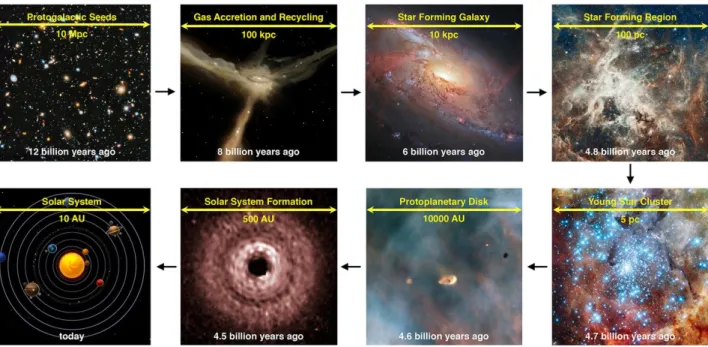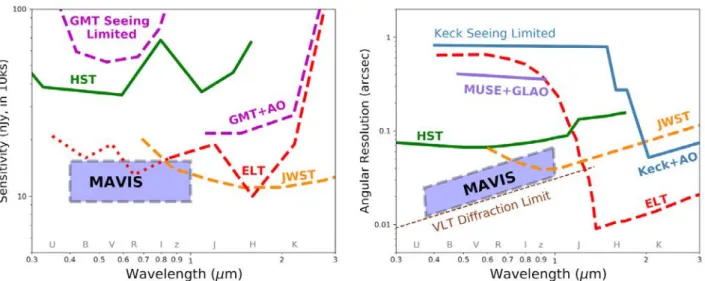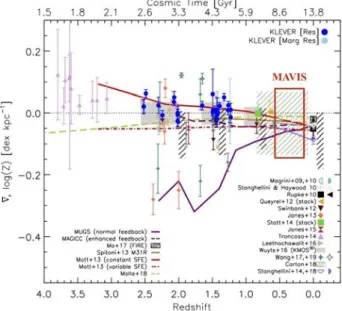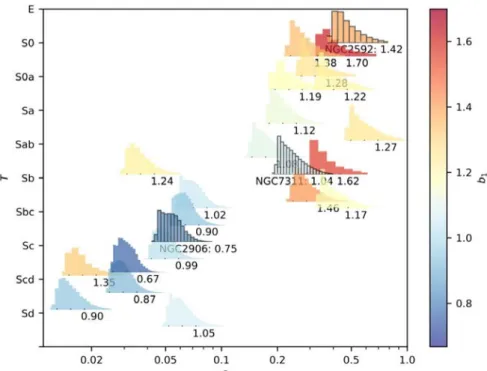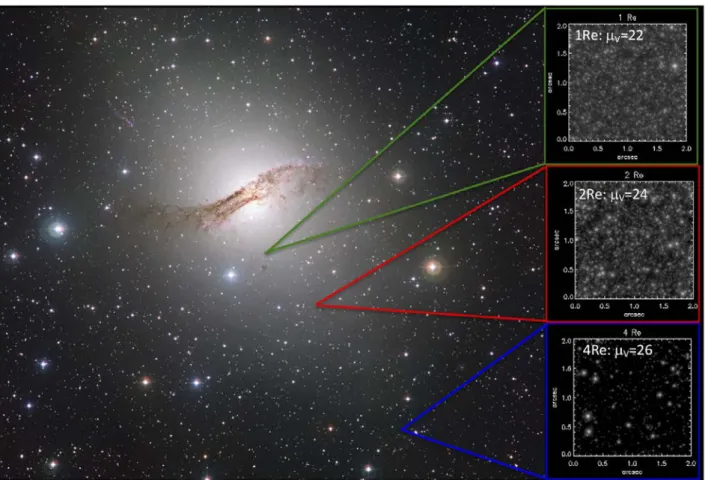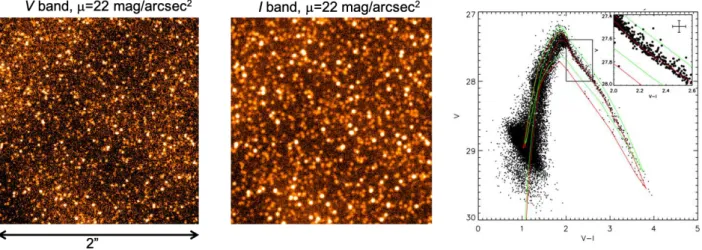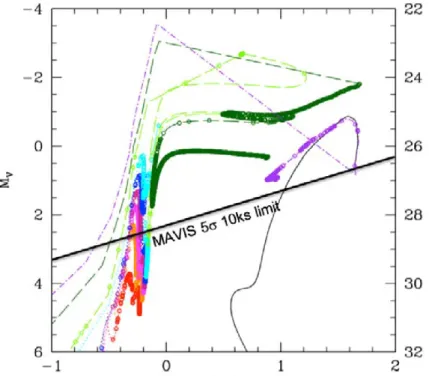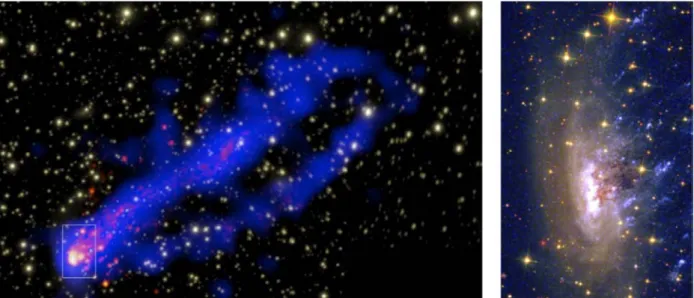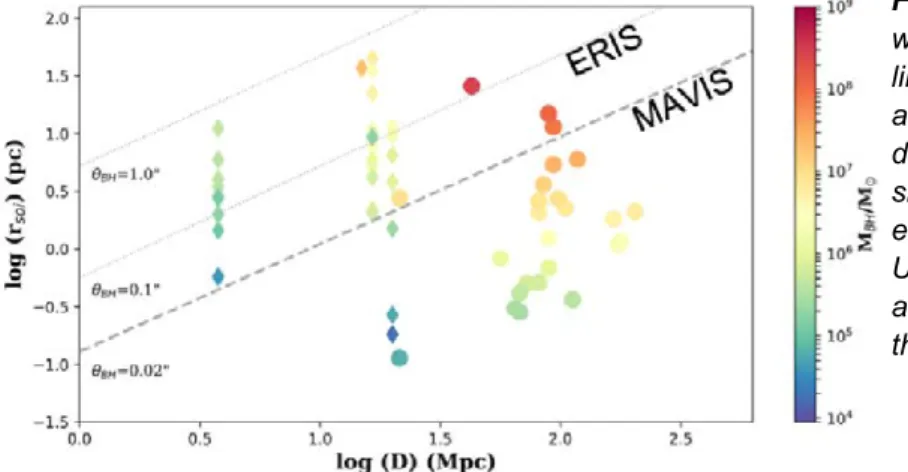HAL Id: insu-03024521
https://hal-insu.archives-ouvertes.fr/insu-03024521
Preprint submitted on 25 Nov 2020HAL is a multi-disciplinary open access archive for the deposit and dissemination of sci-entific research documents, whether they are pub-lished or not. The documents may come from teaching and research institutions in France or abroad, or from public or private research centers.
L’archive ouverte pluridisciplinaire HAL, est destinée au dépôt et à la diffusion de documents scientifiques de niveau recherche, publiés ou non, émanant des établissements d’enseignement et de recherche français ou étrangers, des laboratoires publics ou privés.
VLT Adaptive Optics Facility
Richard M. Mcdermid, Giovanni Cresci, Francois Rigaut, Jean-Claude Bouret,
Gayandhi de Silva, Marco Gullieuszik, Laura Magrini, J. Trevor Mendel,
Simone Antoniucci, Giuseppe Bono, et al.
To cite this version:
Richard M. Mcdermid, Giovanni Cresci, Francois Rigaut, Jean-Claude Bouret, Gayandhi de Silva, et al.. Phase A Science Case for MAVIS – The Multi-conjugate Adaptive-optics Visible Imager-Spectrograph for the VLT Adaptive Optics Facility. 2020. �insu-03024521�
Phase A Science Case
List of Contributors
The MAVIS Phase A Science Case was prepared by the MAVIS Consortium Core Science Team, together with key co-authors from the MAVIS community. The case comprises a distilled set of thematically linked science cases drawn from the MAVIS White Papers submitted by the astronomy community in 2018 (published via the MAVIS blog: www.mavis-ao.org/whitepapers ), and subsequently refined during the Phase A study via community science workshops (see http://mavis-ao.org/Workshops/ ). Specific papers used are highlighted below, selected to illustrate the driving requirements of the instrument. However, all the original White Papers present important and innovative science enabled by MAVIS, and provide a crucial
benchmark for demonstrating the compliance of the instrument design with the community’s science goals. We refer the reader to the links above for further information.
The MAVIS Project gratefully acknowledges the contributions of the many researchers from across the international community who have engaged with the MAVIS Project to date, and whose names and institutions are listed on the following page.
MAVIS Science Case Prepared by: Richard McDermid, Giovanni Cresci, Jean-Claude Bouret, Gayandhi De Silva, Marco Gullieuszik, Laura Magrini, Trevor Mendel, Francois Rigaut, Simone Antoniucci, Giuseppe Bono, Devika Kamath, Stephanie Monty, Holger Baumgardt, Luca Cortese, Deanne Fisher, Filippo
Mannucci, Alessandra Migliorini, Sarah Sweet, Eros Vanzella, Stefano Zibetti White Papers featured:
“ Mass accretion in low-metallicity environments of the outer Galaxy ”, S. Antoniucci et al. “ Frequency of accreting sub-stellar companions of low-mass stars ”, S. Antoniucci et al.
“ Jets from young stars at high angular resolution: the launching mechanism as a solution to the angular
momentum problem ”, F. Bacciotti et al.
“ Resolving the physics of ram-pressure stripping ”, L. Cortese et al.
“ Dynamical measurements of supermassive black holes and nuclear star clusters ”, E. Dalla Bonta et al. “ Probing the cores of globular clusters: Abundance anomalies on the unevolved main sequence stars and
impact of binarity ”, G. De Silva et al.
“ Probing stellar clumps in distant star-forming galaxies around z∼1 ”, M. Dessauges-Zavadsky et al. “ Resolving Super-Massive Black Holes in Compact, Low-Mass Galaxies ”, A. Ferre-Mateu
“ Extreme Star Forming Regions in Galaxies at Cosmic Noon and the Nearby Universe ”, D. Fisher “ Star-forming clumps ”, M. Gullieuszik
“ Spectroscopy of distant Cepheids with MAVIS: A detailed chemical mapping of spiral galaxies in the Local
Universe ”, L. Inno et al.
“ Tracing the chemical evolution of nearby galaxies with star clusters ”, L. Magrini et al. “ A MAVIS deep field ”, F. Mannucci et al.
“ Resolved stellar populations in distant galaxies ”, R. McDermid “ Evolution of the Interstellar Medium with MAVIS ”, T. Mendel et al. “ Exploiting strong lensing clusters with MAVIS ”, P. Rosati et al. “ Star and planet formation at low metallicities ”, G. Sacco et al.
“ Young Massive Clusters in Metal-Poor Starburst Dwarf Galaxies ”, R. Sanchez-Janssen et al. “ Direct detection of UV-upturn hot, old stars in nearby ETGs and bulges ”, S. di Serego Alighieri et al. “ Resolved Angular Momentum with MAVIS: towards a physical morphological classification ”. S. Sweet et al. “ Resolved stellar populations and star formation histories in the Local Universe: Star-forming dwarf galaxies
in the field and in clusters ”, M. Tosi et al.
Additional Contributors: Angela Adamo, Alberto Adriani, Guido Agapito, Ricardo Amorin, Francesca Annibali, Maryam Arabsalmani, Carmelo Arcidiacono, Francesca Bacciotti, Gabriel Bartosch Caminha, Stephanie Basa, Rob Bassett, Giuseppina Battaglia, Luigi Bedin, Michele Bellazzini, Andrea Bellini, Daniela Bettoni, Katia Biazzo, Samuel Boissier, Dylan Bollen, Alessandro Boselli, Veronique Buat, Lucio Buson, Nell Byler, Francesco Calura, Fabrizio Capaccioni, Luca Casagrande, Giada Casali, Barbara Catinella, Laure Ciesla, Michele Cignoni, Fraser Clarke, Claudio Codella, Edvige Corbelli, David Corre, Enrico Corsini, Luca Costantin, Maria Cristina De Sanctis, Virginia Cuomo, Valentina D'Orazi, Elena Dalla Bonta, Ric Davies, Richard de Grijs, Orsola De Marco, Mirka Dessauges-Zavadsky, Sperello di Serego Alighieri, Simon Driver, Simon Ellis, Benoit Epinat, Steve Ertel, Renato Falomo, Davide Fedele, Andrea Ferrara, Anna Ferre-Mateu, Gianrico Filacchione, Giuliana Fiorentino, Duncan Forbes, Elena Franciosini, Ken Freeman, Johan Fynbo, Carme Gallart, Anna Gallazzi, Teresa Giannini, Karl Glazebrook, Davide Grassi, Andrea Grazian, Laura Greggio, Claudio Grillo, Marco Grossi, Brent Groves, Leslie Hunt, Laura Inno, Michael Ireland, Colin Jacobs, Helmut Jerjen, Erkki Kankare, Lisa Kewley, Jacques Kluska, Rubina Kotak, Bertrande Lemasle, Kieran Leschinski, Chengyuan Li, Mattia Libralato, Juan Manuel Alcalá, Dan Maoz, Antonio Marasco, Alessandro Marconi, Elena Masciadri, Davide Massari, Fabrizio Massi, Seppo Mattila, Lucio Mayer, Nicola Menci, Massimo Meneghetti, Amata Mercurio, Matteo Monelli, Lorenzo Morelli, Alessia Moretti, Jeremy Mould, Brunella Nisini, Matthew O'Dowd, Tino Oliva, Ronaldo Oliveira da Silva, Ilari Pagotto, Elena
Pancino, Vera Patricio, Michele Perna, Celine Peroux, Giuseppe Piccioni, Alessandro Pizzella, Linda Podio, Bianca Poggianti, Elisa Portaluri, Sofia Randich, Veronica Roccatagliata, Donatella Romano, Piero Rosati, Michela Rubino, Stuart Ryder, Germano Sacco, Stefania Salvadori, Jorge Sanchez Almeida, Ruben Sanchez-Janssen, Nicoletta Sanna, Daniel Schaerer, Nick Seymour, Mojtaba Taheri, Valentina Tamburello, Maria Teresa Capria, Eline Tolstoy, Crescenzo Tortora, Monica Tosi, Andrea Tozzi, Paolo Tozzi, Alessio Turchi, Jesse van de Sande, Mathieu van der Swaelmen, Schuyler van Dyk, Hans Van Winckel, Benedetta Vulcani, Frederic Vogt, Rachel Webster, Emily Wisnioski, Tayyaba Zafar, Anita Zanella
Contributing Institutions : Australian Astronomical Optics (AAO) - Macquarie University; Australian National University; Astronomisches Rechen-Institut - Heidelberg University; California Institute of Technology; CEA Saclay; City University of New York (CUNY); Curtin University; ETH Zurich; Federal University Rio de Janeiro; INAF Arcetri Astrophysical Observatory; INAF Astronomical Observatory of Padova; INAF Astronomical Observatory of Rome; INAF Astrophysics and Space Science Observatory of Bologna; INAF Capodimonte Astronomical Observatory; INAF Catania Astrophysical Observatory; INAF Istituto di Astrofisica e Planetologia Spaziali (IAPS); Institut de Ciencies del Cosmos Universitat de Barcelona; Instituto de Astrofisica de Canarias (IAC); International Centre for Radio Astronomy Research (ICRAR); Kapteyn Institute University of Groningen; Katholieke Universiteit Leuven; Kavli Institute for Cosmology University of Cambridge; Laboratoire d'Astrophysique de Marseille (LAM); Macquarie University Research Centre for Astronomy, Astrophysics and Astrophotonics (MQAAAstro); Max Planck Institute for Astrophysics; Max Planck Institute for Extraterrestrial Physics; MeteoSwiss; Niels Bohr Institute University of Copenhagen; NRC-Hertzberg; Oskar Klein Centre University of Stockholm; Oxford University; Queen's University Belfast; Space Telescope Science Institute (STScI); Swinburne University of Technology (SUT); Tel Aviv University; UK Astronomy Technology Centre; University of Arizona; University of Ferrara;
University of Geneva; University of Melbourne; University of Milan; University of Padova; University of Pisa; University of Sydney; University of Turku; University of Vienna; University of Western Australia; University of Zurich.
TABLE OF CONTENTS
1 Introduction 7
1.1 MAVIS Instrument Overview 7
1.2 MAVIS Science Overview 9
1.3 MAVIS Operational Context 10
1.4 MAVIS as a General Purpose Instrument 12
1.5 The MAVIS Science Case - Structure of this document 14
2 Emergence of the Hubble Sequence 15
2.1 Introduction 15
2.2 Kinematics and structural properties of the first disk and compact galaxies in the epoch of
Cosmic Change 17
2.3 Resolving ISM variations across cosmic times 21
2.4 Resolving the physical properties of classical bulges and pseudo bulges 24
The observational challenge 24
The connection between morphological structure and angular momentum 26
2.5 Morphology of the first galaxies 28
2.6 Spectroscopy of the first galaxies in the epoch of reionization 31
3 Resolving the Contents of Nearby Galaxies 33
3.1 Introduction 33
Confronting the sub-grid physics of galaxies 34
3.2 Understanding the origin of early-type galaxy envelopes 35
3.3 Solving the origin of the UV-excess in nearby early-type galaxies 37 3.4 Cepheids as probes of galaxy chemistry and the cosmological distance scale 40
3.4.1 Chemical evolution of late-type galaxy disks 40
3.4.2 The calibration of the distance scale 41
3.4.3 Observational Needs 41
3.5 Resolving the physics of ram-pressure stripping 44
3.6 Dynamical measurements of supermassive black holes and nuclear star clusters in low
mass galaxies 47
3.6.1 SMBHs in compact systems 47
3.6.2 Unveiling the connection between SMBHs and Nuclear Star Clusters 50
4 Star Clusters over Cosmic time 53
4.2 Galactic stars clusters: Revealing the mystery of Globular Clusters 54 4.2.1 The origins of multiple populations and chemical peculiarities 55
4.2.2 Core Binaries in the context of cluster formation 56
4.2.3 Technical requirements and Observational outline 57
4.3 The hunt for seed black holes in globular clusters 60
4.3.1 Targets and Observational Outline 62
4.3.2 Simulating the Astrometric Performance of MAVIS 63
4.4 Stars clusters in the Local Universe: Tracers of star formation histories and chemical
evolution 65
4.5 Massive stars in metal poor environments 73
4.5.1 Formation of massive stars 75
4.5.2 Stellar winds at low metallicity 75
4.5.3 Evolution of massive stars 77
4.6 Resolving star forming clumps at intermediate z 78
4.6.1 Resolving star forming clumps within galaxy discs 78
4.6.2 Star formation outside galaxy discs 81
4.7 The origin of the first star clusters: star forming clumps at high-z 81 4.7.1 MAVIS on non-lensed fields: star forming complexes at 100-200 pc scale 82 4.7.2 MAVIS on lensed fields: gravitational bounded star clusters at 1-20 pc scale. 82
5 The Birth, Life, and Death of Stars and Their Planets 85
5.1 Introduction 85
5.2 Young Stars 85
5.2.1 Star and planet formation in low-metallicity environments 85
5.2.2 Formation of jets from young stars and angular momentum problem 87
5.2.3 Formation of sub-stellar companions 90
5.3 Evolved Stars 91
5.3.1 Protoplanetary disks around evolved stars 91
5.3.2 White dwarf binaries 94
5.4 Solar System 96
5.4.1 Comets 96
5.4.2 Outer Solar System objects: Kuiper Belt Objects and rings 99
5.4.3 Outer planets: Uranus and Neptune 100
6 Science Requirements 103
6.2 Strehl Ratio 104
6.3 Strehl Ratio Variation 105
6.4 Wavelength Range 105
6.5 Imaging Field of View 108
6.6 Imaging Sensitivity 109
6.7 Astrometric Performance 110
6.8 Spectroscopy Field of View 110
6.9 Spectroscopy Spectral Resolution 111
6.10 Spectroscopy Spatial Resolution 116
6.11 Spectroscopy Sensitivity 118
6.12 Summary of baseline design compliance with science cases 119
7 Competitiveness and Complementarity 122
7.1 Sky coverage 122
7.2 Imaging Capability 124
7.3 Spectroscopy Capability 126
7.4 Summary of key MAVIS properties 128
References 130
Appendix 1: MAVIS Exposure Time Calculator 137
A1.1 Model components 137
A1.1.1 Detector properties 137
A1.1.2 Sky model 137
A1.1.3 Source models 137
A1.1.4 MAVIS Throughput 137
A1.1.5 Ensquared energy 138
A1.2 Signal-to-noise estimation 139
A1.3 MAVIS Performance 139
A1.3.1 Imager 139
A1.3.2 Spectrograph 140
A1.3.2.1 Limiting magnitude curves 140
1 Introduction
1.1 MAVIS Instrument Overview
The Multi-conjugate Adaptive-optics Visible Imager-Spectrograph (MAVIS) operating on the Adaptive Optics Facility (AOF) of the Very Large Telescope (VLT) is a general-purpose instrument for exploiting the highest possible angular resolution of any single optical telescope available in the next decade, either on Earth or in space, and with sensitivity comparable to (or better than) larger aperture facilities. MAVIS comprises three principal modules (see Rigaut et al. in prep. for a technical description of MAVIS):
- An Adaptive Optics Module (AOM), responsible for wavefront sensing and correction. This features an innovative transmissive design, which includes two post focal deformable mirrors totalling about 4,250 actuators (5,420 including the deformable secondary mirror of the AOF), eight 40x40 Shack-Hartmann LGS wavefront sensors, and three near-infrared natural guide star
wavefront sensors, which also provide low order truth sensing and slow focus corrections.
- An imager module , Nyquist sampling the near-diffraction limited optical beam over a 30”x30” field of view. The imager is equipped with a range of broad- and narrow-band filters, with throughput maximised via minimal re-imaging optics following the AOM.
- An image-slicing integral field spectrograph (IFU) module , with flexible spatial and spectral configurations. Exchangeable fore-optics and dispersing elements provide two spatial modes (0.025” and 0.050” square spaxels, covering respectively 3.6”x2.5” and 7.2”x5” fields of view) each of which have four spectral modes, covering 370nm-1μm at resolutions from 5,000-15,000. The instrument specifications are summarised in Table 1.1, with the top-level requirements and science driver traceability presented in Section 6. Sensitivity estimates are documented in Appendix A.
The MAVIS technical field, from which Natural Guide Stars (NGS) may be selected, covers 120” (see Fig. 1.1), and benefits from some off-axis correction from the post-focal deformable mirrors, enabling at least 50% sky coverage at the Galactic pole. MAVIS will nominally deliver a mean V-band Strehl ratio of >10% (goal >15%), varying less than 10% across the 30”x30” science field. This equates to FWHM-like resolution of <20mas at 550nm. Even in the limiting sky coverage case, MAVIS will ensure >15% of the transmitted V-band light falls within a 50mas square aperture.
Figure 1.1: MAVIS fields of view, showing the
technical (grey), imaging (green), and offset spectrograph/IFU fields (red/peach). Orange stars and the dashed circle indicate LGS positions and their track with field rotation, respectively. As the NGS are sensed in the near infrared, NGS selection does not obstruct the science field and does not impact on
transmission in the visible science band. The Laser Guide Star (LGS) asterism is located at a fixed radius of 17.5”, and comprises 8 individual beacons. These are generated by splitting the beams from the 4 existing AOF LGS units, and whose light is blocked from the science beam via a notch filter. The off-centred IFU provides additional flexibility in guide star selection by rotating the science field position angle.
Table 1.1: An overview of MAVIS characteristics. Performance numbers are for the Paranal standard
conditions, seeing=0.8”@500nm, zenith angle=30 degrees (effective seeing=0.87”).
MAVIS General Properties
Focus Nasmyth A VLT-AOF (UT4) NGS Field of View 120” diameter circle Number of NGS Up to 3
Limiting magnitude Hmag ≥ 18.5
LGS beacons 8
Sky coverage ≥ 50% at Galactic pole
Ensquared Energy ≥ 15% within 50mas at 550nm
Strehl ≥ 10% (15% goal) in V-band, <10% variation (RMS)
MAVIS Imager
Field of View 30” x 30” Pixel Scale 7.4 mas/pix
Filters UBVRI, ugriz, various narrow bands Sensitivity V ≥ 29mag (5σ) in 1hr
MAVIS Integral Field Spectrograph
IFU Spaxel Size and Field of View
Fine Sampling: 20-25mas spaxels, 2.5” x 3.6” FoV Coarse Sampling : 40--50mas spaxels, 5.0” x 7.2” FoV
Spectral Configurations LR-BLUE LR-RED HR-BLUE HR-RED
Median Resolution (λ/λΔ) 5,900 5,900 14,700 11,500
Wavelength 370-720nm 510-1000nm 425-550nm 630-880nm
Sensitivity (ABmag, 10σ in 1hr, Fine Sampling)
1.2 MAVIS Science Overview
By probing the frontier of angular resolution and sensitivity across a large portion of the observable sky, MAVIS will enable progress on an array of scientific topics, from our own planetary system to those around other stars, and from the physics of star formation in the Milky Way to the first star clusters forming in the early Universe (Fig. 1.2).
Figure 1.2: Overview of the cosmic history of our Universe in relation to the relevant physical scales at
different epochs . By providing high angular resolution, sensitivity, and spectral resolving power across most 1
of the sky, MAVIS will enable new discoveries across each of these regimes.
Combined imaging and spectroscopic capabilities are crucial to the overall scientific utility and impact of MAVIS, making full use of the unique access to very high angular resolutions across most of the sky. The
point-source imaging sensitivity of MAVIS will exceed that of the Hubble Space Telescope, giving an order of magnitude higher depth, and with higher angular resolution . The comparatively large field of
view of MAVIS and high sky coverage furthermore open up the possibility for exploration and discovery surveys of these regimes, for example via “deep field” blind surveys, as well as targeted follow-up campaigns. Integral-field spectroscopy will make full use of the exquisite MAVIS image quality, giving the full range of optical diagnostics tracing chemical and dynamical properties across spatially complex and crowded fields, and with spectral resolutions matched to the characteristic mass and physical scale regimes that MAVIS will uniquely probe.
MAVIS will enable access to the new regimes of faint sources and crowded fields that will become commonplace at longer wavelengths in the era of ELTs, but with the diagnostic power of optical wavelengths. This will be particularly important in the low-redshift Universe (z<0.5), where the most well-calibrated and understood physical diagnostics are found at wavelengths below 1μm. In this way,
MAVIS will be a crucial complement to ELT capabilities , delivering comparable angular resolution in the
optical to that delivered by ELTs in the infrared. A key example of this synergy is in studying resolved stellar populations beyond the Local Group. While ELTs will be able to detect individual stars in galaxies beyond
several Mpc with modest integrations times, infrared wavelengths probe mainly the Rayleigh-Jeans tail of the stellar black body spectrum, making infrared colours largely degenerate to key stellar population parameters such as age and metallicity. By contrast, the shallower depths accessible on an 8m telescope are fully compensated by the increased diagnostic power of optical colours, making MAVIS a critical tool for capitalising on ELT science.
The astrometric precision and magnitude limits of MAVIS will exceed that of HST, and extend the ultra-precise local framework from GAIA out to the furthest reaches of the Milky Way and into the Local Group. MAVIS will provide proper motion accuracies of 5-10km/s out to distances of ~100kpc over 5 year timescales, approaching the radial velocity accuracy from MAVIS spectroscopy. The combined spectral and imaging capabilities will provide full 6D phase-space information of individual stars, giving a new precision to studies of intermediate mass black holes in globular clusters, and unique dynamical information to constrain the dark matter properties of local group dwarf galaxies.
The unprecedented combination of sensitivity and angular resolution afforded by MAVIS and the AOF will allow, for the first time, a complete picture of the life of stars across cosmic time, and galaxy morphology, from the earliest phases of the formation of individual stars and planetary systems in our galaxy, to the detailed properties of ancient and chemically distinct stars in massive galaxies, and the fundamental nature and fate of the first star clusters in galaxies at early times. Exploration of these topics aligns well with the science interests of the broader ESO community, and with the robust and flexible operational model envisioned for MAVIS, can be addressed through a variety of observing campaigns, both as dedicated surveys and Large Programs, and through shorter allocations to small teams, as expected for a general purpose facility instrument.
1.3 MAVIS Operational Context
The next 5-10 years will see the fruition of decades of technological development, planning, and investment in astronomy, with the commissioning of the next generation of major optical-infrared astronomical
observatories, including the 6m James Webb Space Telescope (JWST, due to launch in 2021), the 25m Giant Magellan Telescope (GMT, first light 2029), the Thirty Metre Telescope (TMT, first light 2027), and the 39m European Extremely Large Telescope (ELT, first light ~2025). The timeline of these and other facilities at different wavelengths is summarised in Fig. 1.3.
Thanks to their increased aperture size, these much-anticipated facilities will open new regimes of sensitivity and angular resolution, allowing astronomers to probe new parameter space in faintness, distance, mass scales, and ultimately in our understanding of the Universe. However, each of these facilities is optimised primarily for infrared wavelengths, due to both a scientific motivation to push to larger cosmological distances (and therefore red-shifted light), but also largely through the technical demands of engineering tolerances at optical wavelengths on large facilities.
Figure 1.3: Timeline of current and future large observing facilities. All dates are based on published
information from the corresponding observatories at the time of writing.
Fig. 1.4 summarises the capabilities of existing and planned facilities in the parameters of sensitivity and angular resolution at different wavelengths. While the increased aperture sizes of next-generation facilities like JWST and ELT give a consummate increase in sensitivity across the optical/infrared regime, Fig. 1.4 demonstrates that this is not achieved uniformly at all angular scales. Diffraction-limited performance from these large aperture observatories is limited to wavelengths longer than 1 micron. Shortward of this, the best angular resolution available from a general-purpose observatory is that of the Hubble Space Telescope (HST) – a diffraction-limited telescope, but with a comparatively modest 2.4m aperture, providing angular resolution around 0.1”.
The scientific impact of HST has been nothing short of revolutionary over its three decades of operation, thanks to its exquisite image quality which is, until now, unparalleled from the ground. At the time of writing, however, the future of this great observatory is very uncertain. In 2016, NASA extended the science operations support contract for HST to 2021, at the time to provide overlap with the James Webb Space Telescope (JWST). In March 2018, however, the JWST launch was postponed from 2018 to 2021,
effectively eliminating this overlap. Operations can be extended, but the hardware is aging. Since October 2018, HST is down to three operational gyroscopes - the minimum needed for stable pointing and optimal 2
image quality. While mitigation plans are in place to maintain reduced-performance operations with a smaller number of gyroscopes, no service missions are currently planned to replace HST hardware.
Figure 1.4: Comparison of MAVIS with existing (solid line) and future (dashed line, or dotted where
performance is less certain) general-purpose observing facilities. Data were extracted from public sources (instrument handbooks, performance simulators, and exposure time calculators). Left: Limiting point-source
sensitivity as a function of wavelength for a 10σ measurement with 10ksec of integration. The approximate region for MAVIS is indicated, based on the MAVIS ETC (see Appendix A). Right: Angular resolution as a
function of wavelength, with MAVIS operating at or near the VLT diffraction limit. MAVIS compares favourably with ELT-class facilities for sensitivity at optical wavelengths, and uniquely combines this with
high angular resolution.
Uncertainties around the future of HST notwithstanding, the limitations of a 2.4m diffraction-limited aperture will be starkly apparent in the era of JWST and ELTs, as illustrated by the significant difference in depth between HST and these future facilities (Fig. 1.4). And while space, with its drastically reduced atmospheric background, will remain the most competitive and sensitive location for infrared observations via JWST, ground-based ELTs will play a crucial role in clarifying the detailed spatial distribution of sources through exquisite angular resolution on 10mas scales. By achieving the diffraction limit at optical wavelengths, MAVIS naturally allows this role to be complemented in the blue with the existing AOF facility.
1.4 MAVIS as a General Purpose Instrument
In preparation for this Phase A design study, the MAVIS Consortium initiated an open call for scientific White Papers, launched in April 2018. The MAVIS White Paper process resulted in 57 complete individual science applications being proposed, involving 150 researchers from across the international astronomy community (see Fig. 1.5). The original papers are publicly available via the MAVIS website
( www.mavis-ao.org/whitepapers ).
Section 6.12 summarises how the adopted baseline MAVIS design aligns with the White Paper proposals, showing that it is fully compliant with the vast majority of science cases. Scientifically, the White Papers fall into roughly physical scale-specific regimes, evenly spanning the full range of categories considered by ESO’s Observing Programmes Committee (OPC, see Fig. 1.5). This indicates that MAVIS, with its flexible combination of imaging and spectroscopic capabilities, provides a general purpose capability that will satisfy a broad range of science interests in the ESO community. To put this in context, Fig. 1.6 shows the
distribution of MAVIS White Paper topics across OPC categories compared with the proposal requests for existing ESO instruments during a recent observing period. In this figure, all instruments have been ordered by the variance in their distribution across OPC categories - a coarse figure of merit for how ‘general purpose’ the instrument is. This clearly shows that MAVIS sits squarely with other flexible facility instruments like XShooter, HAWKI, FORS2, and MUSE.
Figure 1.5: Statistics derived from the MAVIS White Papers. Left: Break-down of lead author affiliation
countries, and additional statistics. Right: Distribution of MAVIS White Papers across the ESO OPC sub-panel categories, showing a fairly even spread.
Figure 1.6: Example distribution of proposals from ESO observing Period 102 across OPC categories
(category names are as in Figure 1.5). The instruments are listed from left to right in order of increasing variance in the percentages across the categories, with left-most instruments being most evenly spread across the four OPC categories. MAVIS is included here using the distribution of White Paper topics. MAVIS
1.5 The MAVIS Science Case - Structure of this document
This document presents an overview of priority science cases that have been identified by the Consortium through open consultation with the ESO community (MAVIS White Papers - see Section 1.4), and further refined by the MAVIS Science Team through several interactive workshops with the consortium and external stakeholders (See www.mavis-ao.org/Workshops for details, including talk slides). These priority cases are presented in the context of four thematic chapters, namely:
● Emergence of the Hubble Sequence
● Resolving the Contents of Galaxies Beyond the Local Group
● Star Clusters Over Cosmic Time
● The Birth, Life and Death of Stars and their Planets
Each chapter comprises related subsections, each with their own key open questions and distinct applications of MAVIS. Taken together, these combine to illustrate how MAVIS will advance our
understanding of the overall chapter topics. In addition, a number of ‘Case Studies’ are provided, to indicate what actual MAVIS observing programmes will look like, in terms of targets with suitable guide stars, sample sizes, and exposure times.
These main science chapters are followed by a description of the top level science requirements, and how these have been derived from the science cases. This includes a summary of requirements requested from the White Paper process, and of how compliant the baseline instrument is against those same White Paper science cases. Finally, an assessment of how competitive and complementary MAVIS is with existing and planned facilities is presented.
2 Emergence of the Hubble Sequence
2.1 Introduction
The physical underpinnings of morphological differences observed among galaxies in the local Universe and the origin of the so-called “Hubble sequence” is one of the most outstanding yet unsolved problems in astrophysics. Despite the existence of a relatively well understood theoretical framework that describes the assembly of gravitationally bound structures following the dynamics of dark matter halos, the complexity of baryonic physics, with its dissipative and radiative processes and the many flavours of feedback
mechanisms, still hampers the quest for a complete and coherent picture.
Figure 2.1: Epoch of Cosmic Change. The figure shows the star formation rate density of the Universe as
a function of cosmic time (from Madau & Dickinson 2014). From 8 billion years ago until just recently, the population of massive galaxies underwent a dramatic change in fundamental properties. The diagram shows that galaxies decrease their star formation rate by roughly an order of magnitude over this period.
Cutting edge instruments of the last 15 years have shown that the ancient Universe was turbulent and messy. Galaxies at z~1−3 experienced 5-10 times greater star formation rates (Fig. 2.1), had amorphous morphology (e.g. Abraham et al. 1996, see Fig. 2.2), and were fueled with an order-of-magnitude larger gas reservoirs than local Universe galaxies (e.g. Tacconi et al. 2013). Perhaps the most transformative
observations came from the technical innovation of adaptive optics IFU instruments, like SINFONI.
Systematic surveys (e.g Förster Schreiber et al. 2009, Cresci et al. 2009) found that these clumpy systems are not necessarily merging galaxies. Many have ordered, rotationally-dominated kinematics, yet with very high gas velocity dispersions. These kinematics suggest thick, puffy disks unlike that of the Milky Way. KMOS enabled very large surveys at z > 1 (Fig. 2.3) showing that ∼1/2 of galaxies at this epoch are
consistent with this picture of “turbulent, clumpy disk galaxy”. Adaptive optics imaging indicates that the size of star forming regions was 10 times larger than in the Milky Way. The aggregate of these observations motivated a paradigm shift in galaxy evolution models (e.g. Dekel et al. 2009), moving towards one in which smoother yet efficient modes of gas accretion, as well as feedback effects due to outflowing gas, play an important if not dominant role at high-z.
Then 8 billion years ago, at z=1, everything began to change. HST observations reveal a rapid decline in clumpy galaxies from z~1 to z~0.5 (Guo et al. 2015). There is a simultaneous rapid decline in both star
formation (Fig. 2.1) and gas content. At z ≈ 0 these turbulent, clumpy disk galaxies are all but absent. Galaxies in the local Universe are well described by spiral morphologies, reminiscent of the well known Hubble sequence (review by van der Kruit & Freeman 2011). Local galaxies have very low gas velocity dispersions, suggesting that thin, high angular momentum disk galaxies are now dominant. It stands to reason that the underlying drivers of galaxy evolution likely experience a change in nature or abundance that begins roughly at z~1 and is complete before z~0.
The epoch of cosmic time from 8 to 3 billion years ago thus marks a dramatic change in the properties of galaxies, and is one of the most critical times for galaxy evolution. These changes in observational
properties likely represent a fundamental shift in the mechanisms driving galaxy evolution. However, due to a lack of appropriate instrumentation, the properties of galaxies during this period of change, from z ≈ 0.5 to z ≈ 1, are very poorly constrained. MAVIS will be the only instrument on any telescope that is capable
of measuring the morphology, kinematics and the spatially resolved ISM properties of galaxies at the required spatial and spectral resolution during this epoch in which the main modes of galaxy evolution are changing.
Figure 2.2: The Morphological Change in Galaxies : Thousands of hours of observations with HST make
it very clear that galaxies undergo a drastic morphological change between z~1 and z~0.5. Because morphology is not an easily quantified concept, we are not yet able to understand the drivers of this change.
Moreover, the available resolution with HST is not sufficient for detailed measurement of galaxy sub-structures. Resolved morphology, kinematics and chemistry are key. MAVIS will be uniquely
transformative to our picture of galaxy evolution in this epoch of cosmic change.
Fundamental clues to the buildup of the Hubble sequence we observe in the present Universe can also be found by resolving morphological details of the first galaxies beyond z~3, during the earliest stages of galaxy assembly. As discussed above, the fraction of irregular galaxies increases going from low (z ∼ 0) to higher redshifts (z ∼ 3−5; e.g. Brinchmann et al. 1998, Ribeiro et al. 2017), possibly due to merging events or galaxy interactions. Galaxies at z~1 are also much smaller in size than present-day galaxies (from < 1 kpc to ∼ 5 kpc; e.g., van der Well et al. 2014), making their observation challenging. In the rest-frame UV, the largest high-z galaxies display multiple clumps of enhanced star formation (e.g. Elmegreen et al. 2005, Genzel et al. 2011, Forster-Schreiber et al. 2009, 2017). However, tracing galaxy properties out to the highest redshifts is nearly impossible using current instruments, with R e ~500 pc (~80 mas) for the z~6
i-band dropouts: only diffraction limited images at optical wavelengths using an 8m telescope, like
the ones provided by MAVIS, will be able to observe such high-z galaxies with sufficient resolution to reveal significant details of their morphology, and to trace back their evolutionary path.
In addition to the direct study of high-z galaxies, the bulges of local disk/spiral galaxies and their diskless counterparts, the elliptical galaxies, may indeed retain some clues to understand the origin of the Hubble sequence by providing the evidences for the dynamical processes that create such density-enhanced regions (see “Galactic Bulges”, 2015, Laurikainen, Peletier & Gadotti eds. and the contribution by J. Kormendy in particular, for extensive reviews and discussions). Indeed, a detailed analysis of the physical
properties of bulges, of their dynamical state and of their multiphase and stellar content, per se and in relation to the hosted SMBH and to the environment in which a galaxy has been living, is crucial to disentangle the physical mechanisms that lead to the bulge formation/growth and the morphological shaping of galaxies. However, given that the bulges of spirals range between a few tens of pc up to 1-2 kpc half light radius, we are currently reaching the limits of available instrumentation, as angular resolution <100 mas would be needed to sample the physical properties of these objects even at distances of ~20 Mpc.
MAVIS is uniquely suited for this challenge, as it is the only instrument that will simultaneously provide exquisite angular resolution, competing with HST; coverage of the visible wavelength range up to ~1 μm; integral field spectroscopy in the visible with a relatively extended FoV; and enormous sensitivity thanks to the VLT .
2.2 Kinematics and structural properties of the first disk and compact
galaxies in the epoch of Cosmic Change
Science goal: what physical drivers lead to the emergence of thin, high angular momentum disk galaxies in the epoch from z ≈ 0.4 to z = 1.0? Which is the origin of the most compact massive galaxies?
Program details: High resolution imaging and IFU spectroscopy of samples of intermediate redshift galaxies in different mass ranges with the LR-Red and HR-Red gratings, to follow Ha or [OIII].
Key observation requirements: spectral resolution R>5000; wavelength coverage 4500-10000Å; spatial resolution ~ 50 mas.
Uniqueness of MAVIS: large sky coverage in the main extragalactic fields required, in combination with high spectral resolution to resolve the intrinsic velocity dispersion combined with high spatial resolution.
As discussed above, the redshift epoch just shy of z~1.0 may provide a critical linchpin for testing models of galaxy evolution, given the fundamental changes in the properties of the galaxy population: nevertheless, this same period remains very poorly constrained. Wisnioski et al. (2015) present a comprehensive analysis of the redshift evolution of the kinematics of galaxies from IFU surveys (see Fig. 2.3). There is an 8 billion year gap from local Universe surveys to those of the distant past. This gap starts at exactly the redshift interval where morphological and molecular gas surveys tell us that galaxies are changing. Just as it was critical to our picture of z > 1 galaxy evolution, we need kinematic information to understand why galaxies undergo this transition from clumpy, turbulent disks to Hubble sequence galaxies.
Moreover, as thin disks become dominant the substructure of galaxies changes as well. We must be able to characterise the smaller scale structures that are forming at this epoch (e.g. pseudobulges, bars, rings). Current resolution from HST is insufficient for this goal. We need to link the kinematic measurements to the structure to make a full test of models of galaxy evolution.
This huge gap in our picture of galaxy evolution is because there is no instrument, on any telescope, sufficient to measure the kinematics of galaxies in this epoch. For this reason, a
fundamental question remains unanswered: what physical drivers lead to the emergence of thin, high angular momentum disk galaxies during the epoch from z ≈ 0.4 to z = 1.0? To answer this question we must measure the kinematics of disk galaxies at sufficient spatial resolution (of order ∼1 kpc) in this redshift window for a sufficient sample of galaxies. Moreover, we must simultaneously be able to measure their structure/morphology and characterize their local environment. At z ≈ 1 we must be able to resolve at least
0.15 arcsecond to separate out bulges. Higher resolution is preferable as it allows for characterization of the bulge kinematics themselves (e.g. Fabricius et al. 2012).
Figure 2.3: A huge knowledge gap in the kinematic transformation of galaxies :
Observed velocity dispersion of star-forming gas in galaxies over cosmic time, overlaid with the instrumental resolutions of MUSE and MAVIS for redshifted H⍺. Prior to z=1, the gas
dispersion is much higher than observed today, indicating enhanced dynamical motion and/or feedback. At z=0, galaxy disks are dynamically colder, and morphologically more regular. There is, however, currently no instrument that is capable of tracking the kinematics of galaxies during this 8 billion year period of cosmic change. It is a critical epoch of galaxy evolution, and one where MAVIS will make ground
breaking observations. Adapted from Wisnioski et al. 2015.
The strongest emission lines from which kinematics can be measured in galaxies are Hα, Hβ and [OIII]. Current adaptive optics instruments with sky coverage large enough to observe faint galaxies are only able to achieve sufficient FWHM and sensitivity at J band or redder wavelengths. The reddest of these lines, Hα, is not observable with traditional adaptive optics techniques for redshifts less than z ≈ 0.9. Even with currently planned improvements, at these distances using fainter rest-frame near-IR lines, such as Paα and Brγ, is impractical for a significant number of galaxies due to sensitivity limits. Therefore, to study the kinematics of galaxies during this epoch of cosmic transformation requires an optical, AO enabled integral field spectrograph. Because there are multiple bright ionized gas emission lines available, this research can be achieved with spectral coverage of 6300∼10000Å.
Moreover, such an instrument requires a spectroscopic resolution that can adequately identify thin disks with lower velocity dispersion (σ gas ≈ 10−25 km s −1 ). Studies of ionized gas in the local Universe (z ≈ 0) find
that disk galaxies can have velocity dispersion as low as σ gas ≈ 10 km s −1 , which is a fundamental lower limit
set by the thermal broadening of ionized gas in HII regions. This requires a spectral resolution of R~10000. JWST and MUSE may have sufficient sensitivity, but they will not have sufficient spectral resolution. Other than MAVIS there is no present or planned instrument that can study the kinematics of disks at this critical epoch. A high spectral resolution IFU on MAVIS adds a unique, fundamental capability that will open up a critical redshift window for galaxy evolution.
Typical disk galaxies have half-light radii ranging from ∼3-15 kpc, at z = 0.5 this corresponds to diameters of order 5 arcsec, making the MAVIS IFU perfectly suited for the task. The critical addition of high spatial resolution imaging makes MAVIS the ideal instrument for studies of the first thin disk galaxies.
A large body of observations and theory suggest that this same epoch, z~0.3−1.0, is a critical time in which disk galaxies secularly evolve, often producing pseudobulges (reviews in Kormendy & Kennicutt 2004, Athanassoula 2005, Fisher & Drory 2016). This theory of secularly evolving disks makes direct predictions for the change in bulge properties, and how they relate to structure and kinematics of the disk.
Pseudobulges, which exist within roughly 80% of disk galaxies in the local Universe (Fisher & Drory 2012), are thought to be a natural part of disk galaxy evolution. Based on present-day star-formation rates and
stellar masses Fisher et al. (2009) argue that, if secular evolution is responsible for pseudobulges, then pseudobulges must have formed much of their mass during the same epoch of cosmic change.
Figure. 2.4: The initial phase of disk galaxies secular evolution. The figure shows the V band
stellar light surface brightness profile of a typical nearby pseudobulge galaxy (NGC 3169). The red and blue lines indicate what the MAVIS (blue) and HST (red) would be when this disk galaxy is
observed at z~0.7. Using the current state of the art instrumentation (HST), the bulge is unresolved. MAVIS opens a new window to this critical aspect of disk galaxies evolution
Due to the need for spatial resolution, MAVIS will be the only instrument capable of measuring the optical light of the pseudobulges at the point in time when they form. It is this combined need to measure both the kinematics and imaging at fine-spatial scales that makes MAVIS a one-stop-shop for this critical epoch of galaxy evolution. Currently the highest spatial resolution images can reliably achieve of order 0.1 arcsec FWHM. As we show in Fig. 2.4, this is insufficient to properly decompose stellar light profiles at z > 0.5. At z ∼ 0.5 − 1.0 this resolution is only good enough to identify the presence of a bulge, not to characterise any of its properties. Moreover, high spatial resolution is needed to break the known degeneracies between the parameters of Sersic function. The problem becomes even more complicated by the presence of extra components that are widespread in disks, such as bars and rings. Fisher & Drory (2016) argue that a practical resolution limit of 200-300 pc is needed to measure bulges and disks. MAVIS will deliver this with 20-30 mas imaging, in reasonable exposure times (of order 30 min to 1 hour per target).
Similarly to the disk galaxy population, also the massive quiescent galaxies have undergone a significant evolution in their structure and size since high redshift (z>2) to the present-day (see e.g. Toft et al. 2007, van Dokkum et al. 2008, van der Wel et al. 2014). In particular, massive quiescent galaxies (with masses of >10 11 M
Sun ) were much more compact at z~2, with typical effective radii of 1-1.5 kpc, a factor of ~5 smaller
than equally massive quiescent galaxies at z=0. The most plausible scenario to explain the significant increase in size, along with a modest mass growth, of quiescent galaxies is evolution through a series of minor gas-poor merging (e.g. Bezanson et al. 2009, Oser 2012, Cimatti et al. 2012). Such a scenario will have to be confronted with the kinematic properties of high and intermediate redshift galaxies as well, of which little is currently known because of observational limitations due to their compact sizes. Indeed, recent observations from deep, high-resolution imaging surveys based on HST H-band observations have revealed the existence at z>~2 of a population of compact star-forming galaxies that could represent the progenitors of compact quiescent galaxies (Barro et al. 2013, 2017). Compact galaxies (first blue, mainly at high redshift, then red) are thus thought to mark an evolutionary phase that follows the quick accretion of gas in the inner regions of galaxies, possibly as a consequence of a gas-rich merger, and precedes growth through minor gas-poor merging.
A key quantity to constrain this proposed evolutionary sequence is the central stellar mass density (within 1 kpc, corresponding to the typical effective radius of compact quiescent galaxies and the core of their star forming progenitors and their quiescent descendants; see e.g. Barro et al. 2017). Thanks to its exquisite spatial resolution and deep imaging, MAVIS will finally allow to resolve the inner structure and color
gradients of compact massive galaxies (quiescent and star-forming) from intermediate redshift (z~0.4) up to high redshift (~4) in order to understand i) if the compact star-forming and quiescent galaxies are consistent with being the initial and final phase of a merger remnant and of which kind, ii) how the relation between age and structure varies with redshift, and iii) where do the high redshift compact quiescent galaxies end up in the local Universe (e.g. cores of classical bulges, see next section). These data will be a crucial
complement to existing HST NIR observations of compact high- redshift galaxies in order to characterise their structure as traced by stellar populations of different ages. The typical effective radii of intermediate- and high-z compact galaxies are in fact 1-1.5 kpc (0.16”-0.24” at z=0.5; 0.12”-0.18” at z=2): such small sizes require exquisite spatial resolution in order to resolve galaxies on scales of fraction of their effective radii and of their central ~1 kpc core. MAVIS will thus be a unique instrument to characterize the structure of massive compact galaxies in their rest-frame UV-optical on sub-kpc scales, as a resolution of 20-25 mas (FWHM) would allow to resolve ~5-10 spatial bins within 1 Re (and/or within the compact core). In order to sample galaxies with stellar mass >~10 10.5 M
Sun up to z~2 we need to go as deep as R~26 mag. This is
achievable in ~5-10 hr of integration time. Suitable targets of compact quiescent and star-forming galaxies can be extracted from already existing catalogs at intermediate redshift (e.g. BOSS, Damjanov et al. 2014, Tortora et al. 2018) and at high redshift (e.g. GOODS, UKIDSS-UDS, CANDELS, Barro et al. 2017). Moreover, for the brightest/most-massive (R<23) intermediate-z (z<0.8) compact galaxies MAVIS will allow to obtain spatially resolved, moderate spectral resolution spectroscopy. For the typical magnitude and size of our targets, the average surface brightness within Re is expected to be μ r ~ 21 mag/arcsec 2 , with a
central peak possibly going down to <~18 mag/arcsec 2 . Therefore, with ~10 hrs of integration we should be
able to reach a SNR=10 per resolution element in the central regions, while the same goal can be reached in the outer parts applying spatial binning. These observations would therefore allow to measure the velocity and velocity dispersion profiles (and hence the galaxy rotational support) as well as stellar population gradients from stellar continuum and absorption line fitting. This kind of observations will finally allow to measure the central mass density and stellar populations gradients within the typical effective radius of this kind of sources, tracing their inner structure through cosmic time to understand whether the proposed evolutionary sequence can hold also at intermediate redshifts.
The area of science we describe in this section is fundamental to studies of galaxies in general. We have outlined some key studies that on their own would fill a critical gap in our model of galaxy evolution. However, at its base these observations would have endless applicability. Currently SAMI, MaNGA and CALIFA represent many thousands of hours of observations with hundreds of team members and a principal focus of characterising the properties of main-sequence disks at z = 0. It is almost certain that MAVIS will have similarly broad impacts. MAVIS makes it possible to study thin disk galaxies as pristine objects in formation. This is a fundamental shift in how we would address the studies of disk galaxies. Since Edwin Hubble first published Extragalactic Nebulae in 1926, astronomers have been trying to understand the formation of thin disk galaxies, and their relationship to the Hubble Sequence. Indeed, almost every major instrument in astronomy has attempted to explain the Hubble Sequence. The missing piece of this critical question has been the ability to make resolved observations of the first thin disk galaxies. Studies of galaxies in the local Universe with large surveys like SAMI and CALIFA have made drastic leaps forward. These surveys, however, must unravel billions of years of evolution, we still do not know what the conditions at their formation was. Studies of galaxies at larger redshift with instruments like SINFONI and KMOS have likewise been critical, as they tell us what disks were like before they settled into the thin systems like our Milky Way. MAVIS will fill in the missing link to galaxy evolution, allowing us
2.3 Resolving ISM variations across cosmic times
Science goal: How do the properties of the ISM in galaxies evolve between z=1 and z=0?
Program details: IFU spectroscopy across of samples of intermediate redshift galaxies in different mass ranges, with the LR-Red and LR-Blue gratings
Key observation requirements: spectral resolution R~5000 and wavelength coverage 4000-10000 Å; spatial resolution ~ 50 mas.
Uniqueness of MAVIS: large sky coverage in the main extragalactic fields required, in combination with high spectral resolution to resolve the intrinsic velocity dispersion combined with high spatial resolution.
Scaling relations among global properties of galaxies (mass, SFR, chemical abundance, dynamics, dark matter ecc.) have provided a wealth of information about the processes leading to galaxy formation and driving their evolution. Nevertheless, the global galaxy properties are not enough to tell the full story because galaxies are also shaped by a number of internal processes, i.e., affecting different parts of the galaxies in different ways and at different times. Galaxies are regulated by a complex interplay between cosmic gas accretion, merger events, star formation, gas redistribution and gas outflows due to the stellar- and AGN-driven winds (e.g. Somerville & Davé 2015) . All these processes affect different parts of the galaxies in different ways, creating gradients that evolve with time.
Specifically, these events leave imprints on the chemical and dynamical properties of the ISM and on its distribution inside the galaxy and in its circum-galactic medium (CGM). Obtaining the spatially-resolved properties of ISM and CGM across cosmic time is a crucial step-forward for a complete understanding of many processes involved.
Figure 2.5: Simulation of the MAVIS view of a z~0.1 galaxy: Map of the expected S/N ratio on
the Ha line for a main-sequence galaxy at z~0.1. Assumes 25mas spatial sampling and 3 hours on source integration. Based on
high-resolution data for M83, observed as part of the TYPHOON survey.
